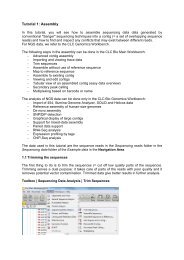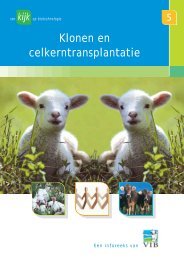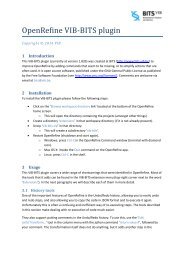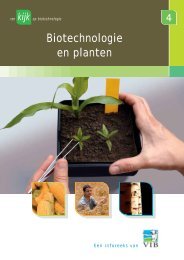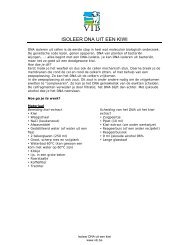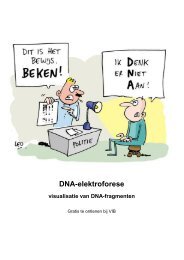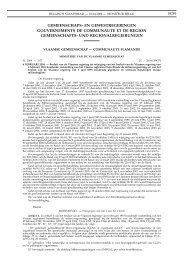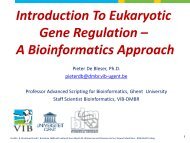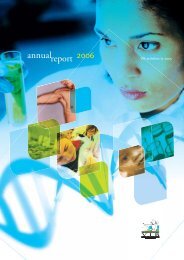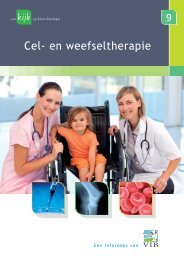Biosafety in the laboratory - VIB
Biosafety in the laboratory - VIB
Biosafety in the laboratory - VIB
You also want an ePaper? Increase the reach of your titles
YUMPU automatically turns print PDFs into web optimized ePapers that Google loves.
<strong>the</strong>refore sufficient to check <strong>in</strong> available catalogues, with suppliers or <strong>in</strong> stra<strong>in</strong> databases (ATCC,<br />
DSMZ, etc.) whe<strong>the</strong>r <strong>the</strong> JM109 stra<strong>in</strong>s belong to <strong>the</strong>se classes of stra<strong>in</strong>s. The answer <strong>in</strong> this case<br />
is: yes, JM109 belongs to <strong>the</strong> E. coli K12 class.<br />
Next, <strong>the</strong> vector’s suitability for risk class I should be determ<strong>in</strong>ed. PUC18 is a well-characterised vector<br />
that has no hazardous properties and is non-self-transmissible. The vector is suited for risk class<br />
I. (a detailed description of <strong>the</strong> requirements for vectors can be found <strong>in</strong> annex 2, chapter A to this<br />
booklet. A description of what is meant by “well-characterised” is also given <strong>the</strong>re). It can <strong>the</strong>refore<br />
be concluded that <strong>the</strong> comb<strong>in</strong>ation of this specific host and vector is suited for risk class I.<br />
Step 2: Now <strong>the</strong> relevant conta<strong>in</strong>ment category can be looked up <strong>in</strong> annex 2. In this particular<br />
case, category 1 of <strong>the</strong> first direction of annex 2, chapter A, is applicable (s<strong>in</strong>ce <strong>the</strong> comb<strong>in</strong>ation<br />
of host and vector is suited for risk class I) However, a f<strong>in</strong>al assessment cannot be given before <strong>the</strong><br />
risk <strong>the</strong> <strong>in</strong>sert itself poses has been determ<strong>in</strong>ed.<br />
Step 3: In this case a piece of bov<strong>in</strong>e genetic material encod<strong>in</strong>g for <strong>the</strong> production of chymos<strong>in</strong>, a<br />
cheese-clott<strong>in</strong>g enzyme, is used. It is well-characterised, known to be no tox<strong>in</strong>, to have noth<strong>in</strong>g to<br />
do with viruses or pathogenic organisms, and to pose no threat <strong>in</strong> any o<strong>the</strong>r way ei<strong>the</strong>r. It can <strong>the</strong>refore<br />
be concluded that category j of <strong>the</strong> second direction of annex 2, chapter A is applicable here,<br />
and that <strong>the</strong> correspond<strong>in</strong>g conta<strong>in</strong>ment level is L1.<br />
Step 4: Are <strong>the</strong>re any special details with regard to (1) <strong>the</strong> environment that might be exposed to<br />
<strong>the</strong> materials, (2) <strong>the</strong> type and level of <strong>the</strong> activities, and (3) any non-standard procedures? In this<br />
particular case only small-scale, standard activities will be performed, such as transformation,<br />
small-scale cultur<strong>in</strong>g of bacteria <strong>in</strong> Erlenmeyer flasks, prote<strong>in</strong> isolation, gel electrophoresis. An activity<br />
is only considered to be large-scale when large volumes are be<strong>in</strong>g produced <strong>in</strong> production facilities.<br />
However, even small fermenters require special attention as far as <strong>the</strong>ir leak tightness and <strong>the</strong><br />
physical conta<strong>in</strong>ment of <strong>the</strong> downstream process<strong>in</strong>g are concerned. In this case no special procedures,<br />
represent<strong>in</strong>g an additional risk or requir<strong>in</strong>g a specific form of additional conta<strong>in</strong>ment, are<br />
performed. The eventual conta<strong>in</strong>ment level will <strong>the</strong>refore be standard L1-conta<strong>in</strong>ment. This<br />
booklet provides <strong>the</strong> follow<strong>in</strong>g <strong>in</strong>formation on this topic:<br />
• L1-conta<strong>in</strong>ment requirements: annex 1 to this booklet<br />
• Detailed SMP-procedures: chapter 5 of this booklet<br />
• Decontam<strong>in</strong>ation and <strong>in</strong>activation procedures: chapter 6 of this booklet.<br />
A possible variation to this example:<br />
Clon<strong>in</strong>g <strong>the</strong> chymos<strong>in</strong> gene <strong>in</strong>to a self-transmissible plasmid <strong>in</strong> E.coli JM109 and transferr<strong>in</strong>g<br />
<strong>the</strong> modified bacteria onto a plastic matrix, dur<strong>in</strong>g which procedure <strong>the</strong> formation of aerosols<br />
cannot be avoided.<br />
In this case, <strong>the</strong> content of step 2 changes: <strong>the</strong> vector does not meet <strong>the</strong> risk class I requirements.<br />
As a consequence, <strong>the</strong> second category of <strong>the</strong> ‘first direction’ of annex 2, chapter A, now becomes<br />
applicable <strong>in</strong>stead of <strong>the</strong> first one. The gene product is still well-known and non-hazardous. As a<br />
result, category j of <strong>the</strong> ‘second direction’ rema<strong>in</strong>s applicable and <strong>the</strong> correspond<strong>in</strong>g conta<strong>in</strong>ment<br />
level is L2. What is more, a very specific aerosol-produc<strong>in</strong>g procedure is be<strong>in</strong>g performed, for which<br />
an additional conta<strong>in</strong>ment measure is required, on top of <strong>the</strong> standard L2 measures: <strong>the</strong> aerosolproduc<strong>in</strong>g<br />
manipulations should be performed <strong>in</strong> a class II safety cab<strong>in</strong>et. The eventual conta<strong>in</strong>ment<br />
level is <strong>the</strong>refore L2, supplemented with <strong>the</strong> use of a class II safety cab<strong>in</strong>et. This booklet<br />
conta<strong>in</strong>s <strong>the</strong> follow<strong>in</strong>g <strong>in</strong>formation on this topic:<br />
• L2 conta<strong>in</strong>ment requirements: annex 1 to this booklet<br />
Work<strong>in</strong>g with commonly used <strong>laboratory</strong> organisms 37



